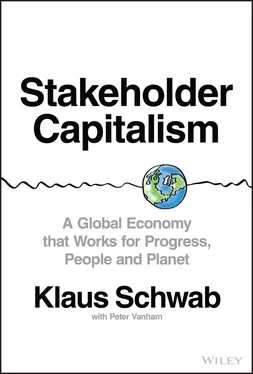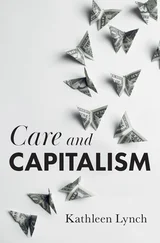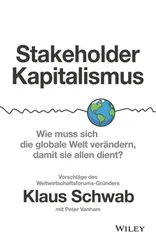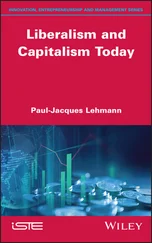Klaus Schwab - Stakeholder Capitalism
Здесь есть возможность читать онлайн «Klaus Schwab - Stakeholder Capitalism» — ознакомительный отрывок электронной книги совершенно бесплатно, а после прочтения отрывка купить полную версию. В некоторых случаях можно слушать аудио, скачать через торрент в формате fb2 и присутствует краткое содержание. ISBN: , Жанр: economics, на английском языке. Описание произведения, (предисловие) а так же отзывы посетителей доступны на портале библиотеки ЛибКат.
- Название:Stakeholder Capitalism
- Автор:
- Жанр:
- Год:неизвестен
- ISBN:9781119756149
- Рейтинг книги:4 / 5. Голосов: 1
-
Избранное:Добавить в избранное
- Отзывы:
-
Ваша оценка:
- 80
- 1
- 2
- 3
- 4
- 5
Stakeholder Capitalism: краткое содержание, описание и аннотация
Предлагаем к чтению аннотацию, описание, краткое содержание или предисловие (зависит от того, что написал сам автор книги «Stakeholder Capitalism»). Если вы не нашли необходимую информацию о книге — напишите в комментариях, мы постараемся отыскать её.
Individual agency:
A clearly defined social contract:
Planning for future generations:
Better measures of economic success: Stakeholder Capitalism: A Global Economy that Works for Progress, People and Planet
Stakeholder Capitalism
Stakeholder Capitalism — читать онлайн ознакомительный отрывок
Ниже представлен текст книги, разбитый по страницам. Система сохранения места последней прочитанной страницы, позволяет с удобством читать онлайн бесплатно книгу «Stakeholder Capitalism», без необходимости каждый раз заново искать на чём Вы остановились. Поставьте закладку, и сможете в любой момент перейти на страницу, на которой закончили чтение.
Интервал:
Закладка:
The result was unbalanced growth. Economic growth returned in the 1980s, but an ever smaller part of the population benefited from it, and even more harm was done to the planet to achieve it. Union membership started to decline, and collective bargaining became less common (though much of continental Europe, including Germany, France, and Italy clung to it until the 2000s, and some, like Belgium, still do today). Economic policies in two of the West's leading economies—the United Kingdom and the United States—were largely geared toward deregulation, liberalization, and privatization, and a belief that an invisible hand would lead markets to their optimal state. Many other Western economies later followed their path, in some cases after more left-leaning governments failed to jumpstart economic growth. On a more positive note, new technologies also made their contribution, leading to a Third Industrial Revolution. The personal computer was invented and would become one of the key components of every organization.
Die Wende
These trends did not happen in isolation. As the 1980s progressed, the economies of Eastern Europe started to collapse. Their failure at this industrial transition point showed that the state-led economic model put forth by the Soviet Union was less resilient than the market-based one promoted by the West. In China, the government of new leader Deng Xiaoping started its own Reform and Opening-Up in 1979, gradually introducing capitalist and market-based policies (see Chapter 3 3 The Rise of Asia The view from the Sham Chun River in Southern China offers a stark contrast. On its southern bank, rice paddies stretch almost as far as the eye can see. On its northern bank, skyscrapers dominate the skyline. It wasn't always so. Forty years ago, there was almost nothing on either side of the river. The most developed part was on the southern banks, where the city of Hong Kong was a few miles out. Train tracks connected the British-ruled “Northern territories” with the empty Chinese mainland across the river. A lone Chinese guard would inspect the river's crossing point. Four decades later, the contrast isn't one a visitor from the past might have expected. The rice paddies to the south still belong to Hong Kong, the long-time financial capital of Asia. But the skyscrapers to the north are now part of contemporary China's technology capital, Shenzhen, a city that appeared out of nowhere. What happened north of the Sham Chun River in those 40 years, represents perhaps the greatest economic miracle ever. In 1979, those living there had an average income of less than a dollar a day. Today, Shenzhen has a per capita GDP of almost US$30,000, about a 100-fold increase over 1979. It is home to tech giants such as Huawei, Tencent, and ZTE, 114 and a “maker movement” of tech start-ups. Hong Kong didn't stand still either, but it now has a formidable twin next door. How did this turnaround happen? And what does it tell us about the broader shift of the world economy to the East?
).
In 1989, Germany experienced a moment of euphoria, as the Berlin Wall, which separated East from West, fell. Shortly thereafter, political reunification of Germany was at last established. And by 1991, the Soviet Union had officially disintegrated. Many economies that lay in its sphere of influence, including those of East Germany, the Baltics, Poland, Hungary, and Romania, turned toward the West and its capitalist, free-market model. “The end of history,” as Francis Fukuyama would call it later, 21 21 The New York Times Magazine , “What Is Fukuyama Saying? And to Whom Is He Saying It?”, James Atlas, October 1989, https://www.nytimes.com/1989/10/22/magazine/what-is-fukuyama-saying-and-to-whom-is-he-saying-it.html .
had arrived, it seemed. Europe got another boost, this time leading to even deeper political and economic integration and the establishment of a common market and a monetary union, with the euro currency as its apex.
At Davos, we felt the winds of change as well. Whereas initially the European Management Forum had been primarily a meeting place between European and American academics, policymakers, and businesspeople, over the course of the 1980s it had become global. The 1980s saw the inclusion of representatives from China, India, the Middle East, and other regions and a shared, global agenda. By 1987, a name change had become necessary. We were thenceforth known as the World Economic Forum. It was fitting for the era of globalization that followed.
Globalization in the 1990s and 2000s
Indeed, following the Soviet Union's collapse, for more than a decade the world's economies became more intertwined. Countries all over the world started to set up free-trade agreements, and the motors of global growth were more varied than ever. The relative importance of Europe declined, and so-called emerging markets, such as South Korea and Singapore but also larger ones such as Brazil, Russia, India, South Africa, and, of course, China, came to the forefront. (There is no formal definition of emerging markets, as it's a classification made by particular private financial institutions, but one common trait that they share is that they are non-Western economies that often have or had higher-than-average growth rates for a number of years, which could help them gain or regain developed-economy status over time.)
In this way, globalization—a process of growing interdependence between the world's economies, signaled by increasing flows of goods, services, people, and capital—became a dominant economic force. Trade globalization, measured by international trade as a percentage of global GDP, reached its highest level ever—15 percent—in 2001, up from 4 percent at its nadir in the Year Zero of 1945.
Swabia's prominent companies surfed this wave of globalization, too. “China was at the top of ZF's agenda,” Siegfried Goll, then a prominent ZF manager, testified in the company's written history. 22 22 “Pioneers in China,” 1993, ZF Heritage, zf.com/mobile/en/company/heritage_zf/heritage.html .
“The development of our business relations began already in the 1980s, initially by means of license contracts. When I retired in 2006, we had no fewer than 20 production locations in China.” According to the company's own records, “The first joint venture was established in 1993,” and by 1998, “ZF's position in China was so firmly entrenched that the first-ever founding of a fully owned Chinese subsidiary was possible: ZF Drivetech Co. Ltd. in Suzhou.”
For some, though, this globalization was too much, too quickly. In 1997, several Asian emerging economies experienced a severe financial crisis, caused in large part by unchecked financial globalization, or the flow of hot money, international investor money that flows easily from one country to another, chasing returns, relaxed capital controls, and bond speculation. At the same time, in the West, an anti-globalization movement took hold, as multinational companies started to have more control over national economies.
Even Ravensburger didn't escape the backlash. In 1997, the company management announced that it wished to “introduce a ‘pact for the safeguarding of production sites,’ as a ‘preventive initiative for the maintenance of national and international competitiveness,’” the European Observatory of Working Life wrote in a later case study on the mater. 23 23 Eurofound, “Pacts for Employment and Competitiveness: Ravensburger AG,” Thorsten Schulten, Hartmut Seifert, and Stefan Zagelmeyer, April 2015, https://www.eurofound.europa.eu/es/observatories/eurwork/case-studies/pecs/pacts-for-employment-and-competitiveness-ravensburger-ag-0 .
The result was the so-called Ravensburger Pact, in which the company offered its employees job security in exchange for concessions.
Интервал:
Закладка:
Похожие книги на «Stakeholder Capitalism»
Представляем Вашему вниманию похожие книги на «Stakeholder Capitalism» списком для выбора. Мы отобрали схожую по названию и смыслу литературу в надежде предоставить читателям больше вариантов отыскать новые, интересные, ещё непрочитанные произведения.
Обсуждение, отзывы о книге «Stakeholder Capitalism» и просто собственные мнения читателей. Оставьте ваши комментарии, напишите, что Вы думаете о произведении, его смысле или главных героях. Укажите что конкретно понравилось, а что нет, и почему Вы так считаете.












